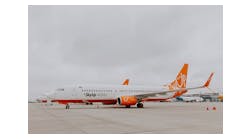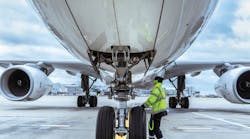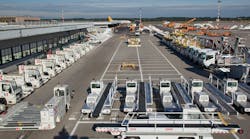Long Beach, Calif. -- Executives from Transportation Network Company (TNC) Lyft made a presentation at the American Association of Airport Executives (AAAE) 89th annual conference here May 8 outlining its plans to operate in more airports.
Don Griffin, Lyft’s business development manager for airports and venues, served as a business specialist for Metropolitan Washington Airports Authority for 12 years. “Lyft and Uber are the two most dominant TNCs, and there’s been a dramatic change in the airport space,” he said. “Overall, we went from 10 cities in 2015 to 200 today.” Lyft also serves more than 200 airports.
What’s driving that growth? “There’s been a big increase in TNC driving, which has generated more revenue for airports,” said Griffin. “We pay trip fees every time we pick up a passenger and sometimes even when we drop one off.”
Fees range from 50 cents at smaller airports to $5 at hubs, said Griffin. “It’s really based on what other ground transportation is available and the size of the airport,” he said.
More airports are offering a separate staging area for TNCs, said Griffin. “These areas are beneficial to all parties, because they reduce wait times for passengers and move traffic away from the airport.
“Passengers get their bags and use the app to request a Lyft. We have four different products: Lyft Line for shared rides, Lyft Classic (up to four seats), Lyft Plus (six or more seats) and Lyft Premier for luxury vehicles,” he said.
Lyft, founded in 2014, competed 160 million rides in 2016, compared with 53 million in 2015, said Griffin. “Fifty-two percent of passengers use Lyft to get to and from the airport,” he said. “We offer safe, reliable rides seven days a week. And customers can even schedule a ride in advance the night before.”
Griffin described three newer innovations that offer more convenience for passengers, especially those going to and from airports. “When a Lyft passenger is dropped off, our Rematch program allows that driver to pick up another passenger instantly rather than go through the staging lot,” he said. “We look at Rematch on a case-by-case basis when queue times at airports are longer.”
Lyft also does pre-dispatching of drivers based on historical trends, said Griffin. “This allows drivers to get to the curb five minutes before an expected passenger request,” he explained.
And there’s the new Lyft Amp device in vehicles, said Griffin. “The device is a light box with Lyft that can change colors. Those colors will also show up on a passenger’s app so they can better match up with their driver,” he said. “It’s rolling out now and we hope to have it completed by the end of the year.”
The biggest roadblock for Lyft in airports is legislation, said Griffin. “And Lyft is working with local governments and airports to expand service,” he said.





